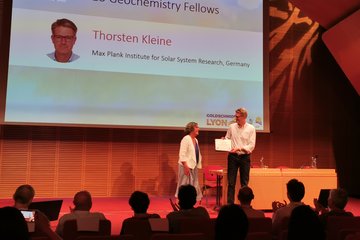Alle Typen
161.
Konferenzbeitrag
The formation of one-lobed Stokes V profiles in an inhomogeneous atmosphere. In: Advanced Solar Polarimetry - Theory, Observation and Instrumentation, S. 371 - 378 (Hg. Sigwarth, M.). (2001)
162.
Konferenzbeitrag
Intensification of a magnetic field in a stellar convection zone by conversion of potential energy. In: Magnetic Fields Across the Hertzsprung-Russell Diagram, S. 165 - 168 (Hg. Mathys, G.; Solanki, S. K.; Wickramasinghe, D. T.). Astronomical Society of the Pacific, San Francisco, USA (2001)
163.
Konferenzbeitrag
Storage of a strong magnetic field below the solar convection zone. In: Cool Stars, Stellar Systems, and the Sun, S. CD - 738 (Hg. López, G.; J., R.; Rebolo; R.; Osorio, Z. et al.). Astronomical Society of the Pacific, San Francisco (2001)
164.
Konferenzbeitrag
Numerical simulation of solar magneto-convection (review). In: Advanced Solar Polarimetry - Theory, Observation and Instrumentation, S. 343 - 354 (Hg. Sigwarth, M.). Astronomical Society of the Pacific, San Francisco, USA (2001)
165.
Konferenzbeitrag
Buried flux tubes in the coronal graveyard. In: Cool Stars, Stellar Systems and the Sun, S. CD - 1114 (Hg. López, G.; J., R.; Rebolo; R.; Osorio, Z. et al.). Astronomical Society of the Pacific, San Francisco (2001)
166.
Konferenzbeitrag
Magneto-Convection (review). In: Magnetic Fields Across the Hertzsprung-Russell Diagram, S. 115 - 123 (Hg. Mathys, G.; Solanki, S. K.; Wickramasinghe, D. T.). Astronomical Society of the Pacific, San Francisco, USA (2001)
167.
Vortrag
Warum sind Sterme magnetisch? Vortragsreihe "Faszinierendes Weltall", Förderkreis Planetarium Göttingen e.V., Göttingen (2017)
168.
Vortrag
A few aspects of photospheric physics (invited). 15th European Solar Physics Meeting, Budapest, Hungary (2017)
169.
Vortrag
Photospheric research: where are we and what's next? (invited). NSO Workshop #30: High resolution solar physics: past, present, future, Sacramento Peak Obs., New Mexico, USA (2017)
170.
Vortrag
Solar magnetic fields: from complexity to simplicity (invited). 48th Meeting of the AAS Solar Physics Dvision, Portland, Oregon, USA (2017)
171.
Vortrag
The surprising simplicity of the global solar dynamo. 17th MHD Days, Göttingen, Germany (2016)
172.
Vortrag
The Babcock-Leighton solar dynamo. SOLARNET III / HELAS VII / SpaceInn Conference "The Sun, the stars, and solar-stellar relations", Freiburg, Germany (2015)
173.
Vortrag
The cause of the weak solar cycle 24. SOLARNET III / HELAS VII / SpaceInn Conference "The Sun, the stars, and solar-stellar relations", Freiburg, Germany (2015)
174.
Vortrag
Small-scale dynamo action in the Sun. ISSI Workshop on "Solar Magnetic Fields: From Measurements Towards Understanding", Bern, Switzerland (2015)
175.
Vortrag
Die magnetische Sonne. 2. Nacht des Wissens, Göttingen, Germany (2015)
176.
Vortrag
The Babcock-Leighton solar dynamo. Stellar and Planetary Dynamos, Göttingen, Germany (2015)
177.
Vortrag
Solar surface magnetism. Colloquium MPI for Astrophysics, Garching (2014)
178.
Vortrag
Small-scale magnetic structure at the solar surface. Seventh Solar Information Processing Workshop, La Roche-en-Ardenne, Belgium (2014)
179.
Vortrag
Simulation of magnetic structure in the photosphere. Annual meeting of the Astronomische Gesellschaft, Splinter session on "High Resolution Physics'', Bamberg, Germany (2014)
180.
Poster
MHD simulations of surface convection in cool main-sequence stars. Cool Stars 18, Flagstaff, USA (2014)











